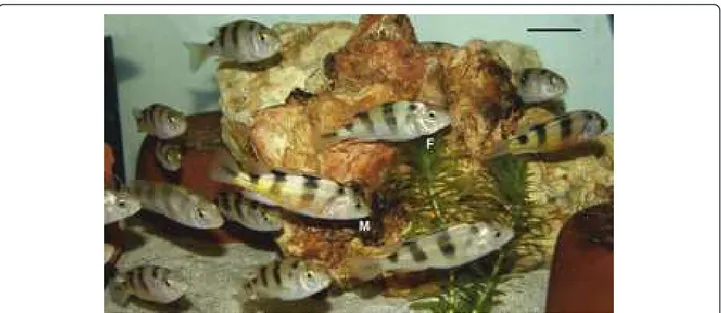C O R R E C T I O N
Open Access
The B chromosome of the cichlid fish
Haplochromis obliquidens
harbors 18S rRNA genes
Andréia B Poletto, Irani A Ferreira and Cesar Martins
*Correction
After the publication of our work [1], we detected that the species focus of the study,Astatotilapia latifasciata
(Figure 1), was erroneously identified asHaplochromis obliquidens. This species was described asHaplochromis latifasciatus[2] and later ascribed to the genus Astatoti-lapia [3]. Our mistake comes from the fact that this species is also frequently listed asHaplochromis “zebra obliquidens”in the aquarium trade.Astatotilapia latifas-ciatahas been reported to occur in Lake Nawampasa a small satellite lake of the much larger Lake Kyoga, and in Lake Kyoga located north of Lake Victoria in Uganda [3].
Received: 7 January 2012 Accepted: 19 January 2012 Published: 19 January 2012
References
1. Poletto AB, Ferreira IA, Martins C:The B chromosome of the cichlid fish Haplochromis obliquidensharbors 18S rRNA genes.BMC Genetics2010, 11:1.
2. Regan CT:New cichlid fishes from lakes Victoria, Kyoga, and Albert.Ann Mag Nat Hist1929,10:388-392.
3. Greenwood PH:Towards a phyletic classification of the‘genus’ Haplochromis(Pisces, Cichlidae) and related taxa. Part II; the species from Lakes Victoria, Nabugabo, Edward, George and Kivu.Zoology Series
1980,39:1-102.
doi:10.1186/1471-2156-13-3
Cite this article as:Polettoet al.:The B chromosome of the cichlid fish Haplochromis obliquidensharbors 18S rRNA genes.BMC Genetics2012
13:3.
* Correspondence: cmartins@ibb.unesp.br
UNESP - Universidade Estadual Paulista, Instituto de Biociências, Departamento de Morfologia, Botucatu, SP, Brazil
Figure 1Specimens ofAstatotilapia latifasciata. M, male; F, female. Scale bar, 3 cm. Polettoet al.BMC Genetics2012,13:3
http://www.biomedcentral.com/1471-2156/13/3
